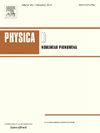Thermocapillary weak viscoelastic film flows on a rotating substrate
IF 2.7
3区 数学
Q1 MATHEMATICS, APPLIED
引用次数: 0
Abstract
We analyze the dynamics and stability of a thin viscoelastic film on a rotating, nonuniformly heated inclined plane, assuming weak rotation and a region far from the axis. The centrifugal force’s effect on instability is a key focus, with Walter’s B rheology used for the viscoelastic liquid. By applying the long-wave approximation, we derive a nonlinear evolution equation for the local film thickness, capturing the interplay of viscoelasticity, rotation, thermocapillarity, and gravity in the low Reynolds number regime. Linear stability analysis shows that the linear growth rate of disturbances is influenced by the viscoelastic parameter, centrifugal force, and Marangoni stresses, while the linear wave speed is affected by rotation and thermocapillarity, but not viscoelasticity. A weakly nonlinear stability analysis reveals distinct instability regions, with both supercritical stable and subcritical unstable zones governed by rotation, thermocapillarity, and viscoelasticity. Numerical studies show that rotation enhances wave height, and viscoelasticity and thermal effects further amplify it. Additionally, viscoelasticity, rotation, and thermal effects impact nonlinear wave speed, though nonuniform heating reduces wave propagation. Full numerical simulations confirm the results from linear and weakly nonlinear analyses.
求助全文
约1分钟内获得全文
求助全文
来源期刊

Physica D: Nonlinear Phenomena
物理-物理:数学物理
CiteScore
7.30
自引率
7.50%
发文量
213
审稿时长
65 days
期刊介绍:
Physica D (Nonlinear Phenomena) publishes research and review articles reporting on experimental and theoretical works, techniques and ideas that advance the understanding of nonlinear phenomena. Topics encompass wave motion in physical, chemical and biological systems; physical or biological phenomena governed by nonlinear field equations, including hydrodynamics and turbulence; pattern formation and cooperative phenomena; instability, bifurcations, chaos, and space-time disorder; integrable/Hamiltonian systems; asymptotic analysis and, more generally, mathematical methods for nonlinear systems.
 求助内容:
求助内容: 应助结果提醒方式:
应助结果提醒方式:


